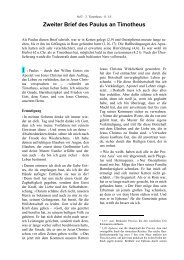You also want an ePaper? Increase the reach of your titles
YUMPU automatically turns print PDFs into web optimized ePapers that Google loves.
glands, as well as blood capillaries and lymphatic<br />
vessels. In contrast, the thickness of the outer<br />
layer, the epidermis (Greek epi = upon, above;<br />
derma = skin), is only between 0.07 and 0.12 mm.<br />
<strong>Our</strong> skin separates our bodies from the outside<br />
world. It encloses us, gives us our individual<br />
shapes, protects us from intruders, cools or<br />
warms us, and conserves our body liquids. Surprisingly,<br />
it contributes about one sixth of our<br />
body weight, although the epidermis itself<br />
weighs only about 500 g. The total area of the<br />
skin amounts to approximately 1.6 square<br />
metres. It is watertight, washable, and elastic. The<br />
skin is thickest on the palms of our hands and on<br />
the soles of our feet, and thinnest in the armpits<br />
and on the eyelids.<br />
<strong>Our</strong> skin – by numbers: One square centimetre<br />
of skin contains:<br />
6,000,000 cells<br />
100 sweat glands<br />
15 sebaceous glands<br />
5,000 sensory corpuscles<br />
200 pain points (receptor areas)<br />
25 pressure points<br />
12 cold-sensitive points<br />
2 heat-sensitive points<br />
The most important property of the skin is that it<br />
contains our <strong>sense</strong> of touch, which is located in<br />
the dermal layer. The outer layer is insensitive,<br />
rubs off easily, and causes the ring left in the<br />
bath after bathing.<br />
The <strong>sense</strong> of touch is difficult to investigate. All<br />
the other <strong>sense</strong>s have a definite key organ which<br />
can be studied, but the skin is spread over the<br />
entire body and cannot easily be delimited or<br />
“switched off”. In the case of vision, scientists can<br />
observe blind persons to learn more about seeing,<br />
and they can study deaf people to learn<br />
more about hearing. But this is impossible for the<br />
<strong>sense</strong> of touch.<br />
Touching is ten times as strong as verbal or emotional<br />
contact. If touching were not pleasant,<br />
living things would not procreate. If we did not<br />
enjoy touching and caressing, there would be<br />
no sex.<br />
A foetus feels the moist warmth inside the womb;<br />
it perceives the heartbeats and the internal<br />
rhythms of its mother. The <strong>sense</strong> of touch is the<br />
first <strong>sense</strong> to develop. It functions automatically,<br />
before the newborn baby’s eyes even open to<br />
observe the world.<br />
It has been discovered that there are many more<br />
kinds of receptors than the four basic ones<br />
through which we experience warmth, coldness,<br />
pain, and pressure. All the different tactile sensations<br />
are more complex than these four, and they<br />
cause us to respond variously.<br />
Tactile experiences (Latin tactilis = touchable):<br />
Mechanical stimuli cause several different sensations:<br />
stroking, touching, vibration, pressure, and<br />
tension. The fingertips and the tip of the tongue<br />
are especially sensitive. The fingertips can feel a<br />
sharp point if the impression is only 10 µm, and<br />
in the case of a vibrating stimulus pressed into<br />
the skin, can feel it even if this is less than 1 µm.<br />
Other functions of the skin: In addition to its<br />
important function as a tactile <strong>sense</strong> organ, there<br />
are several others, of which only a few are mentioned<br />
below:<br />
1 The skin protects passively, as well as actively,<br />
against injurious external influences. It can<br />
destroy invading infective agents.<br />
2 The skin plays an important role in controlling<br />
the temperature of the body, which should not<br />
deviate from 37° C because most <strong>organs</strong> function<br />
optimally at this temperature. Heat loss can be<br />
increased or reduced by increasing or reducing<br />
the flow of blood through the skin’s network of<br />
small blood vessels. About three quarters of the<br />
heat loss is effected by radiation and conduction.<br />
The other quarter is effected by the evaporation<br />
of water, partly unnoticed through the skin and<br />
the lungs, and partly by perspiration. The invisible<br />
evaporation through the skin comprises one third<br />
of the total dermal loss of water.<br />
41
















